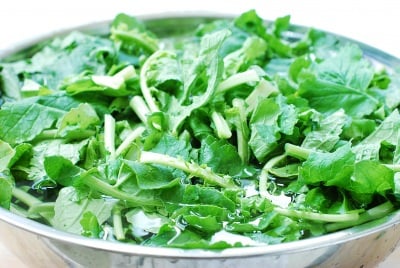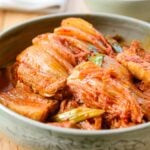
You already know a Korean table (bapsang, 밥상) isn’t complete without kimchi. In summer, that kimchi is most likely this yeolmu kimchi (열무 김치) both at home and restaurants. Yeolmu is young summer radish greens. It’s a variety of white radishes with tender, long greens, and a thin, small root. It’s not the top leafy part of mature white radishes or chonggak mu (young radish), which is much tougher.
Very commonly, young napa cabbage, called putbaechu (풋배추) or eolgari (얼가리), is also added to yeolmu kimchi, giving it a different texture and flavor. I like the ratio of radish greens to young cabbage to be 2:1. You can use only the radish greens without any young cabbage, if you want.
This recipe also works with putbaechu(without any yeolmu), but then the kimchi is called putbaechu (or eolgari) kimchi, not yeolmu kimchi.
Look for the radish greens that have slightly plump stems, not too thin and not too thick, with dark green leaves. You can cut off the root part if it’s too thin and tiny, or use it if it’s big enough.
It’s important to handle these vegetables with gentle care. If bruised, they will develop a grassy taste (called putnae, 풋내) which will linger in kimchi.
These vegetables reduce in volume significantly once salted. This recipe yields about 1 gallon of kimchi. If that’s too much for you, the recipe can easily be cut in half.
For cooler weather kimchi, we generally use sweet rice flour paste, but here I used all purpose wheat flour for a lighter tasting kimchi. The flour paste helps reduce the grassy taste and feeds healthy bacteria during fermentation.
Another ingredient that makes this summer kimchi tastes nice and refreshing is fresh red chili peppers. You can find them in Korean markets, and use them by blending with other seasoning ingredients. If you can’t find them, use gochugaru (Korean red chili pepper flakes) instead.
We Koreans love to use this crunchy and refreshing yeolmu kimchi in bibimbap, bibim guksu, or in naengmyeon. I hope you try making it while summer is still here!
For more Korean cooking inspirations, follow along on YouTube, Pinterest, Twitter, Facebook, and Instagram.

Ingredients
Young radish greens and cabbages
- 4 pounds yeolmu 열무 (young radish greens)
- 6 tablespoons Korean coarse sea salt use less if using finer salt
- 4 cups of water
- 2 pounds putbaechu 풋배추 (young napa cabbages)
- 3 tablespoons Korean coarse sea salt use less if using finer salt
- 2 cups water
Seasoning Ingredients
- 6 fresh red chili peppers roughly chopped
- 10 plump garlic cloves
- 2 inch-long, about 1 inch-round ginger roughly chopped
- 1/4 cup salted shrimp saewujeot 새우젓
- 1/4 cup fish sauce myulchiaekjeot, 멸치액젓
- 3 to 4 tablespoons gochugaru Korean chili pepper flakes - use 1/2 cup or more if not using fresh peppers
- 1 tablespoon sugar
Flour Paste
- 2 tablespoons flour
- 2 cups of water
Other vegetables
- 5 or 6 thin scallions cut into 1-inch long pieces
- 1/2 large onion thinly sliced
Instructions
- Cut off the root end of each radish if the root is thin and not usable. Otherwise, cut the thin end of the root and scrape off the impurities with a small knife. Trim off any bad leafy stems, and cut the greens into about 3-inch long pieces. Transfer to a large bowl.
- Trim off the root from each young cabbage. Cut the cabbages into about 3-inch long pieces, and transfer to another large bowl.
- Fill the bowl of greens with water. Let them sit in the water for about 10 minutes for the greens to release any dirt. Then, wash the greens a couple of times by gently shaking with your hands in the water. Drain. Do the same with the young cabbages.
- Dissolve 6 tablespoons of salt in 4 cups of water in a small bowl. Placing a handful of the greens back in the large bowl, sprinkle with some salt water. Repeat the process until all the radish greens are placed in the bowl. If you run out of salt water, pour some back out of the bowl with the greens and use again. Repeat the process for the young cabbages in another bowl with 3 tablespoons of salt and 2 cups of water.
- Let the vegetables sit for 40 minutes to an hour until they become slightly flexible. Flip them over once or twice while salting.
- Meanwhile, mix the flour well with water, and boil over medium heat, stirring, to make the flour paste. Cool.
- Coarsely blend the chili peppers, garlic, ginger and saewujeot together with 1/2 cup of water in a blender. Combine with the fish sauce, gochugaru, sugar and flour paste.
- Gently rinse the salted radish greens and cabbages separately in cold water, and drain well.
- Place the radish greens and cabbages in 3 to 4 batches in the same large bowl, pouring in some seasoning mix each time. Add the scallions and onions. Toss everything very lightly by hand (use kitchen gloves), until everything is evenly coated with the seasoning.
- Store in an airtight container or jar (about 1 gallon size). Leave it out at room temperature for a few hours before storing in the fridge. You can start eating kimchi any time, but it will taste best after a few days in the fridge.































